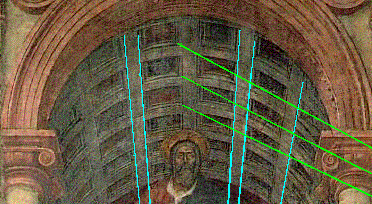
Masaccio, The Trinity, Santa Maria Novella, Florence (detail).


The superimposed blue lines follow the ``horizontal'' ribs of the vaulting and converge at the vanishing point lower in the fresco. This puts the horizon line approximately 174cm above the bottom of the fresco, which measures 667cm high and 317cm wide. The vault is cylindrical but the squares down the central rib are close enough to horizontal for the diagonals to be tested. They all meet the horizon line near a point about 770cm from the vanishing point. The backwards construction then places the ideal viewpoint at 174cm (about 5 feet 8 inches) above the bottom of the fresco (which is at the floor) and 770cm (25 feet 3 inches) away from the work. Click here for an image of the complete construction.
|
|
|
© Copyright 2001, American Mathematical Society |